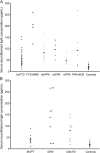Serum neurofilament light chain protein is a measure of disease intensity in frontotemporal dementia
- PMID: 27581216
- PMCID: PMC5047041
- DOI: 10.1212/WNL.0000000000003154
Serum neurofilament light chain protein is a measure of disease intensity in frontotemporal dementia
Abstract
Objective: To investigate serum neurofilament light chain (NfL) concentrations in frontotemporal dementia (FTD) and to see whether they are associated with the severity of disease.
Methods: Serum samples were collected from 74 participants (34 with behavioral variant FTD [bvFTD], 3 with FTD and motor neuron disease and 37 with primary progressive aphasia [PPA]) and 28 healthy controls. Twenty-four of the FTD participants carried a pathogenic mutation in C9orf72 (9), microtubule-associated protein tau (MAPT; 11), or progranulin (GRN; 4). Serum NfL concentrations were determined with the NF-Light kit transferred onto the single-molecule array platform and compared between FTD and healthy controls and between the FTD clinical and genetic subtypes. We also assessed the relationship between NfL concentrations and measures of cognition and brain volume.
Results: Serum NfL concentrations were higher in patients with FTD overall (mean 77.9 pg/mL [SD 51.3 pg/mL]) than controls (19.6 pg/mL [SD 8.2 pg/mL]; p < 0.001). Concentrations were also significantly higher in bvFTD (57.8 pg/mL [SD 33.1 pg/mL]) and both the semantic and nonfluent variants of PPA (95.9 and 82.5 pg/mL [SD 33.0 and 33.8 pg/mL], respectively) compared with controls and in semantic variant PPA compared with logopenic variant PPA. Concentrations were significantly higher than controls in both the C9orf72 and MAPT subgroups (79.2 and 40.5 pg/mL [SD 48.2 and 20.9 pg/mL], respectively) with a trend to a higher level in the GRN subgroup (138.5 pg/mL [SD 103.3 pg/mL). However, there was variability within all groups. Serum concentrations correlated particularly with frontal lobe atrophy rate (r = 0.53, p = 0.003).
Conclusions: Increased serum NfL concentrations are seen in FTD but show wide variability within each clinical and genetic group. Higher concentrations may reflect the intensity of the disease in FTD and are associated with more rapid atrophy of the frontal lobes.
© 2016 American Academy of Neurology.
Figures


Comment in
-
Comment: "If you can't measure it, you can't improve it" (Lord Kelvin).Neurology. 2016 Sep 27;87(13):1335. doi: 10.1212/WNL.0000000000003164. Epub 2016 Aug 31. Neurology. 2016. PMID: 27581215 No abstract available.
References
-
- Seelaar H, Rohrer JD, Pijnenburg YA, Fox NC, van Swieten JC. Clinical, genetic and pathological heterogeneity of frontotemporal dementia: a review. J Neurol Neurosurg Psychiatry 2011;82:476–486. - PubMed
-
- Rohrer JD, Zetterberg H. Biomarkers in frontotemporal dementia. Biomark Med 2014;8:519–521. - PubMed
-
- Rosengren LE, Karlsson JE, Sjögren M, Blennow K, Wallin A. Neurofilament protein levels in CSF are increased in dementia. Neurology 1999;52:1090–1093. - PubMed
-
- Sjögren M, Rosengren L, Minthon L, Davidsson P, Blennow K, Wallin A. Cytoskeleton proteins in CSF distinguish frontotemporal dementia from AD. Neurology 2000;54:1960–1964. - PubMed
MeSH terms
Substances
Grants and funding
LinkOut - more resources
Full Text Sources
Other Literature Sources
Miscellaneous
